|

from
CrystaLinks Website
Stretching across the Nazca plains like
a giant map or blueprint left by ancient astronauts, lie the famous
Nazca Lines of Peru. Peru is associated with the Incan Civilization
who many link with alien visitors who still interact with local
people to this day.
No one has proof who built them or why. Since their discovery, the
Nor rituals probably related to astronomy, to confirm the ayllus
or clans who made up the population and to determine through
ritual their economic functions held up by reciprocity and
redistribution, or a map of underground water supplies. Nazca Lines
have inspired fantastic explanations from ancient gods, a landing
strip for returning aliens, a celestial calendar created by the
ancient Nazca civilization -- putting the creation of the lines
between 200 BC and 600 AD, used for rituals probably related to
astronomy, to confirm the ayllus or clans who made up the population
and to determine through ritual their economic functions held up by
reciprocity and redistribution, or a map of underground water
supplies.
There are also huge geoglyphs in Egypt, Malta, United States
(Mississippi and California), Chile, Bolivia and in other countries.
But the Nazca geoglyphs, because of their numbers, characteristics,
dimensions and cultural continuity, as they were made and remade
through out the whole prehispanic period, form the most impressive,
as well as enigmatic, archeological group.
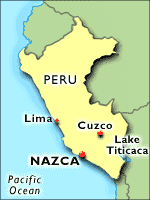 Location Location
The Nazca Lines are located in the Nazca Desert, a high arid plateau
that stretches between the towns of Nazca and Palpa on the pampa (a
large flat area of southern Peru). The desolate plain of the
Peruvian coast which comprises the Pampas of San Jose (Jumana),
Socos, El Ingenio and others in the province of Nasca, is 400 Km.
South of Lima, covers an area of approximately 450 km2,
of sandy desert as well as the slopes of the contours of the Andes.
They cover nearly 400 square miles of
desert. Etched in the surface of the desert pampa sand about 300
hundred figures made of straight lines, geometric shapes most
clearly visible from the air.
Nazca
Plain
The Nazca plain is virtually unique for its ability to preserve the
markings upon it, due to the combination of the climate (one of the
driest on Earth, with only twenty minutes of rainfall per year) and
the flat, stony ground which minimizes the effect of the wind at
ground level. With no dust or sand to cover the plain, and little
rain or wind to erode it, lines drawn here tend to stay drawn. These
factors, combined with the existence of a lighter-coloured subsoil
beneath the desert crust, provide a vast writing pad that is ideally
suited to the artist who wants to leave his mark for eternity.
The pebbles which cover the surface of the desert contain ferrous
oxide. The exposure of centuries has given them a dark patina. When
the gravel is removed, they contrast with the color underneath. In
this way the lines were drawn as furrows of a lighter color, even
though in some cases they became prints. In other cases, the stones
defining the lines and drawings form small lateral humps of
different sizes. Some drawings, especially the early ones, were made
by removing the stones and gravel from their contours and in this
way the figures stood out in high relief.
The concentration and juxtaposition of the lines and drawings leave
no doubt that they required intensive long-term labor as is
demonstrated by the stylistic continuity of the designs, which
clearly correspond to the different stages of cultural changes.
Designs,
Myths and Metaphors
There appear to be various designs consisting of figures of animals,
flowers and plants, objects, and anthropomorphic figures of colossal
proportions made with well-defined lines. An example of this is the
drawing of a weird being with two enormous hands, one normal and the
other with only four fingers.
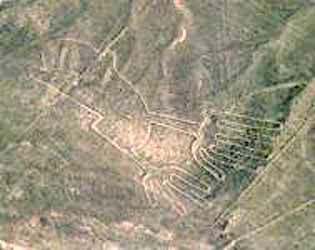
Gray Alien hand
vs. Human Hand?
Also represented are drawings of
man-made objects such as yarn, looms and "tupus" (ornamental
clasps). All these figures have well-defined entrances which could
be used as paths or to allow people to line together along the
conformations of the drawings.
The anthropomorphic figures are relatively few and are situated on
the slopes. The most well-known being is The Astronaut at 32m length
discovered by Eduardo Herran in 1982.
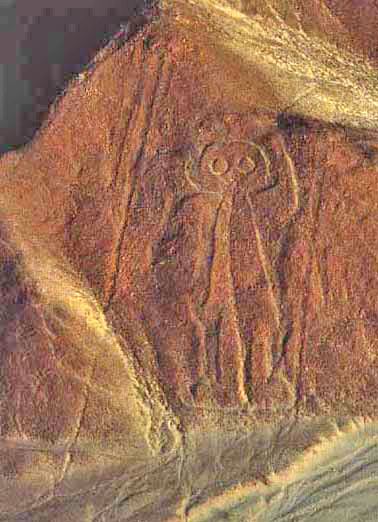
Ancient
Astronaut?
The lines are many kilometers long and
crisscross sectors of the pampas in all directions. Many of the
lines form geometric figures: angles, triangles, bunches, spirals,
rectangles, wavy lines, concentric circles.
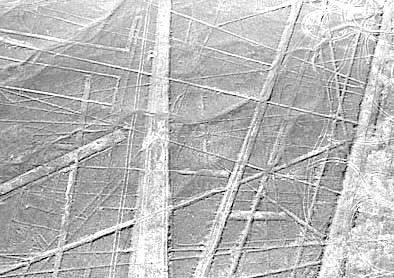
X - Hourglass?
Programmed in Time?
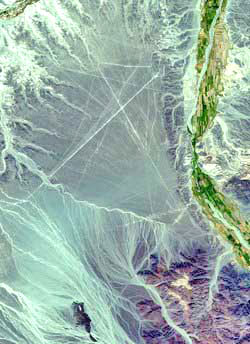
Satellite Image NASA
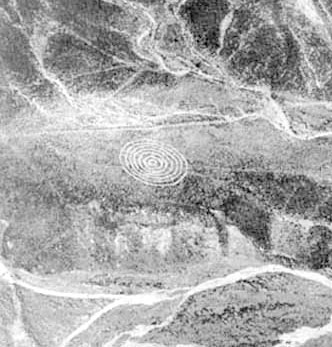
Spiral of consciousness? Fibonacci? Sacred Geometry?
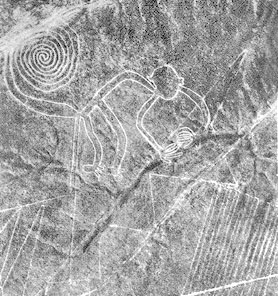
The Monkey has a Spiraling Tail --
The Evolution of Humanity and Consciousness?

A Dog? Other four-legged animal?
 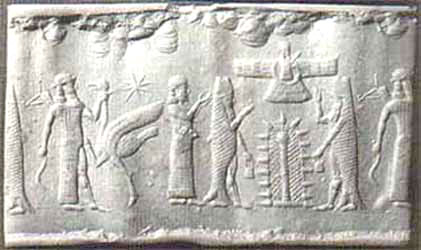
Amphibious Gods -- Creation from the Sea?
The winged image of Zoroaster, above, takes us to ...

...Gods With Water Buckets
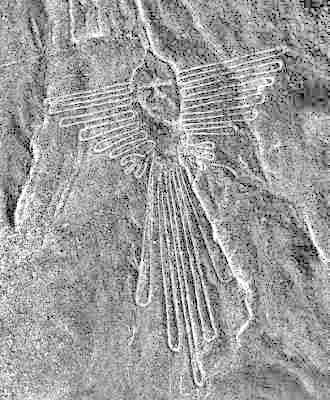 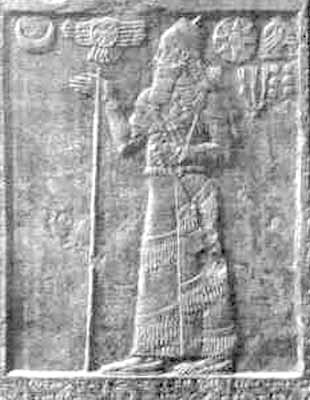
Headless Bird -- Sumerian Gods -- Top of Rod resembles Zoroaster
Image
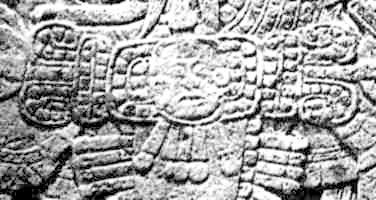 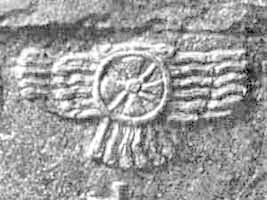
Mayan Sun God -- Mayan Calendar - 2012? -- Quetzalcoatl who is
Zoroaster
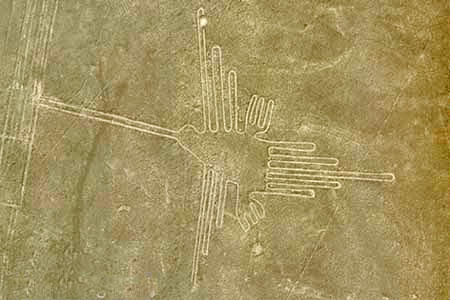
Bird Headed Beings
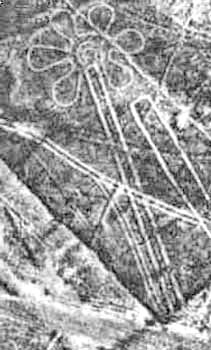
Six-petal Flower of Life?
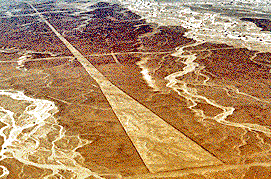
Trapezoidal designs - Pyramid design pointing above?
Map
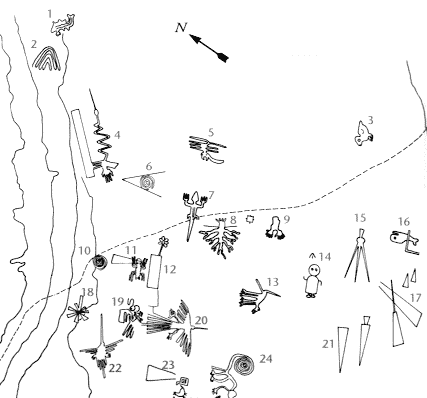
|
1. Killer Whale
2. Wing
3. Baby Condor
4. Bird
5. Animal
6. Spiral
7. Lizard
8. Tree
9. Hands
10. Spiral
11. Spider
12. Flower
13. Dog |
14. Astronaut
15. Triangle
16. Whale
17. Trapazoids
18. Star
19. Pelican
20. Bird
21. Trapazoid
22. Hummingbird
23. Trapezoid
24. Monkey
25. Llama
26. Trapezoids |
Composition
The Lines were allegedly made by removing the iron-oxide coated
pebbles which cover the surface of the desert. When the gravel is
removed, they contrast with the light color underneath. In this way
the lines were drawn as furrows of a lighter color.
Off the Pampa,
south of the Nazca Lines, archaeologists have now uncovered the lost
city of the line-builders, Cahuachi. It was built nearly 2,000 years
ago and mysteriously abandoned 500 years later.
Discovering the Nazca Lines by Outsiders
The Nazca Lines were first spotted when commercial airlines began
flying across the Peruvian desert in the 1920’s. Passengers reported
seeing ’primitive landing strips’ on the ground below. Today people
sometimes fly in hot air balloons to view the splendors of the Nazca
Lines, their energies awakening something within their souls.
Theories
Toribio Mejia Xespe, a Peruvian doctor and anthropologist was the
first scientist, in 1927, to show interest in what he called "great
Incan ceremonial artifacts".
Maria Reiche was a German mathematician and archaeologist who was
famous for researching the Nazca Lines. She believed the lines were
an Astronomical Calendar indicating the direction of the rising of
important stars and planetary events like sun solstices. Formations
like the spider and the monkey could show star constellations like
Orion and Ursa Mayor. The problem with all astronomical theories is
the unknowing of the age. The direction of stars changes within
centuries, explained by the precession of the equinoxes.
Reiche led a determined effort to discredit theories of
extraterrestrial visitors. She argued that the Nazca Indians
constructed the Lines some time between 300 BC and AD 800. In
support of this possibility, some scientists have put forward
ingenious ideas on how the geoglyphs could theoretically have been
designed from the ground. The more important evidence, however, is
that which attempts to link the Lines definitively to the Nazcan
culture. Here, neither of the two key pieces of evidence survive
close scrutiny.
The first piece of evidence is a series of radiocarbon dates, based
on ceramic and wood remains which were left at the Lines by the
Nazcan people. It is claimed that this proves that the Nazcans
constructed the Lines. On the contrary, the dating of these
materials tells us only that the Nazcans lived in the area of the
Nazca Lines. Since the Lines themselves cannot be radiocarbon dated,
the possibility remains that they already existed when the Nazcan
culture emerged.
The second piece of evidence is the alleged resemblance of the Nazca
geoglyphs to certain features found on Nazcan pottery. This is an
important issue because it potentially offers proof that the Nazcans
had either designed the images or at least viewed them from the air.
Maria Reiche died in 1998 at the age of 95. She is buried in the
arid valley she loved so well.
Professor Gerald Hawkins and his group went to Nazca to prove the
astronomical Theory of Maria Reiche but was unsuccessful. In 1968, a
study by the National Geographic Society determined that, while some
of the Nazca lines did point to the positions of the Sun, Moon and
certain stars two thousand years ago, it was no more than could be
expected by mere chance. In 1973, Dr Gerald Hawkins studied 186
lines with a computer program and found that only 20 per cent had
any astronomical orientation - again no more than by pure chance.
In 1980 Georg Petersen pointed out that Reiche’s theory did not
explain the different lengths and widths of the lines.
More recently, Johan Reinhard has noted that the surrounding
mountains provided a ready-made and much more effective mechanism
for the Nazcans to use as a solar calendar; the lines would thus
have been quite superfluous to them.
Simone Waisbard stated that the drawing of Nazca are a giant
astronomical calendar. Further the Nazca-line-system was used to
measure the precipitation value. Figures, especially seabirds, have
a connection to the meteorological prophecy system of the Nazca-Culture.
Her ideas for the trapezoid formations: places for holy animals
before sacrifice them, or field claims connected with filter
galleries, observatories or places for ritual ceremonies of the
different clans.
Swiss writer Erich von Daniken suggested, in his 1968 book,
Chariots
of the Gods, that the lines were built by ancient astronauts as a
landing strip. But the soft clay soil and layer of brown and black
rocks in the Nazca desert would seem an unsuitable site for landing
and were blown away by the power of rocket propulsion. The aliens
left - never to return - leaving the people confused. Like in the
modern cargo cults they tried to call the Gods back by drawing
lines, figures and trapezes.
Alan F. Alford concluded that the Nazca-Lines was made by Negroid
Slaves of the
Tihuanaco Culture. After a revolution the Negroid
population destroyed some figure, this is the explanation for
overdrawn zigzag-formations. Later this people went in northern
direction and founded Chavin and the Olmec culture.
Robert Bast linked the lines to the Flood Stories in his book
A
Memory of the Deluge. The animal, plant and human-shaped figures are
lying together on the ground as a memorial place of the big flood.
Gilbert de Jong wrote A Nazcan Zodiac. He traveled to Nazca and
measured the GGF by GPS. He obtained a length of the square side of
about 54,7 Meter. In the formation he recognized a Zodiac.
Robin Edgar believed that the Nazca Figures were inspired by, and
intended to be seen by, the (so-called) Eye of God that is
manifested during total solar eclipses. An extraordinary series of
solar eclipses coincided with the construction of the
Nazca lines.
Some Lines are aligned with the winter solstice, a less spectacular
but more regular, death and rebirth of the Sun God.
Michael Coe believes the Nazca Lines are sacred paths to walk by
specific rites. The primary lines were an offering for elders,
heaven, and mountain deities who gave them water for their fields.
 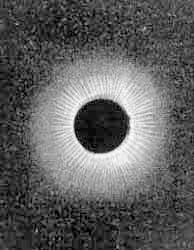
Nazca Lines and the Eye in the Sky Eclipse
Siegfried Waxmann recognized a culture
atlas of the human history in the Nazca-line-system.
Archaeologist Frederico Kauffmann-Doig believes that the Nazca Lines
are magic lines which originate from the cat cult in Chavin de
Huantar.
Markus Reindel’s Dwsing Theory says that the Nazca Figures are
markers for a subterranean waterflow. Trapezoides show the broadness
of the waterstream, zigzaglines show where they end, lines show into
direction of the puquitos. He explain the nature of the figures by
rod-dowsing (to find the subterranean water) and shamanistic flights
(to overview the figures).
The Code of Carl Munck - The Ancient Geomatria of Numbers
--The
Nazca Line ground markings locate themselves on The Code Matrix
system -
Nazca Lines and Archaeocryptography.
The ancient sites around
the world are very precisely positioned on a global coordinate
system in relation to the position of the Great Pyramid at Giza. The
positions of the sites are given in the geometry of their
construction. A very ancient system of numbers was used in the
system, which we will call Gematria. Gematrian numbers are found in
ancient myths and religions, including the Bible.
Gematrian numbers were used in systems
of weights and measures by ancient peoples, including the Greeks,
the Egyptians, the Persians, the Babylonians and the Romans. The
Code system uses mathematical constants, such as pi and the radian.
The system also uses conventions that are still in use, such as the
360 degree circle, 60 minute degree, 60 second minute, the base-ten
numbering system, the 12-inch foot, and the 5280-foot mile.
The ancient Mayans used Gematrian numbers in their very accurate
timekeeping.
Professor Helmut Tributsch states that important cult places like
Stonehenge, the Pyramids and the Nazca Lines were built in power
areas where often the Fata Morgana Phenomena occurs.
Thomas Wick is a private researcher of ancient mysteries. In his
book A Plan of a Cathedral he writes that when he saw the figure of
the GGF, he recognized the ground principals of a cathedral.
Henri Stierlin wrote that the Nazca Indians used the line-system as
looms using strings. They sometimes organized hundreds of men who
held the strings -- their positions defined by the Nazca Lines.
Prof. Helaine Siverman says that the figures are clan signs of
different Indian clans in the region of Nazca.
Ellie’s Theories
-- The Nazca Lines will remain an enigma. I do not
see them as a landing strip for returning space ships and creator
gods. Some patterns are by human design but not all. The major Nazca
Lines follow the same universal archetypes found all over the world
extending throughout the universe. As human consciousness is going
through a process of evolution - the lines are one of many reminders
and triggers of who we are and where we are going.
Creation is part of a geometric
blueprint that repeats in cycles of time created by the same
consciousness. Stone markers are placed in power points around the
planet - as they are places humans are drawn to explore on their
quest for the truth about their creation and purpose for being here.
The key is scared geometry and understand the holographic nature of
our reality and how the Nazca Lines are an insert in the program.
Nazca People -
Cahuachi
On the pampa, south of the
Nazca Lines, archaeologists have now uncovered the lost city of the
line-builders, Cahuachi. It was built nearly two thousand years ago
and was mysteriously abandoned 500 years later. New discoveries at
Cahuachi are at last beginning to give us insight into the Nazca
people and to unravel the mystery of the Nazca Lines.
In general, Nazca culture is considered to consist of three stages;
Early, Middle, and Late stages, and also the Classic Nazca
(approximately A.D. 250-750). One of the most famous and distinctive
features of the Nazca culture is the polychrome pottery which has
attracted attention because of its technological refinement and the
exciting symbolism of its motifs. This pottery culture spreads in
the area of the valleys of Chincha, Pisco, Ica, Nazca and Acari.
In the Early stage, these wares did not have much color, but Middle
and Late Nazca polychromes are buff or red and are painted in three
to eight colors. The most popular choices of color were red, black,
white, brown, yellow, gray and violet with an outline in black.
Bowls and beakers were common forms, but double-spout and
head-and-spout jars are also found. Birds, fish or fruits were
commonly drawn on the pottery, and Nazca’s religious or mythological
features were also used in its design.
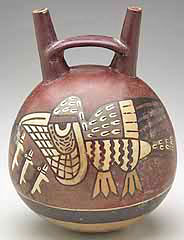
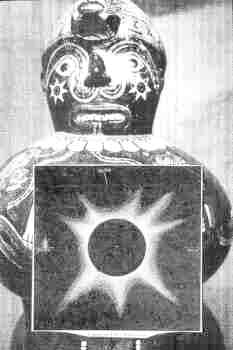
Nazca Figurine
depicting Solar Eclipse and the Eye of Creation.
Cahuachi was a major ceremonial center
of the Nazca culture and overlooked some of the Nazca lines from 1
CE to about 500 CE. Italian archaeologist Giuseppe Orefici has been
excavating the site for the past few decades, bringing a team down
every year. The site contains over 40 mounds topped with adobe
structures.
The permanent population was quite small, but it was apparently a
pilgrimage center that grew greatly in population for major
ceremonial events. These events probably involved the Nazca lines
and the giant sand dune of Nazca. Support for the pilgrimage theory
comes from archaeological evidence of sparse population at Cahuachi
and from the Nazca lines themselves which show creatures such as
killer whales and monkeys which were not present in the Nazca
region.
Trade or travel may explain the images.
Due to the dry climate the finds are quite rich and include even
such ephemeral material as clothing. Looting is the greatest problem
facing the site today.
Weaving

Burial Sites
Most of the burial sites surrounding Cahuachi were not known until
recently and so present a very tempting target for archaeologists.
Their ancient technique of weaving, that the Nazca people developed,
has given an insight into how the lines may have been made, and what
they might have been used for more than 1,500 years ago.
Mummies
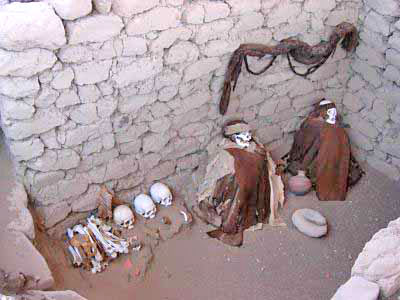
Most exciting is the
discovery of human remains.
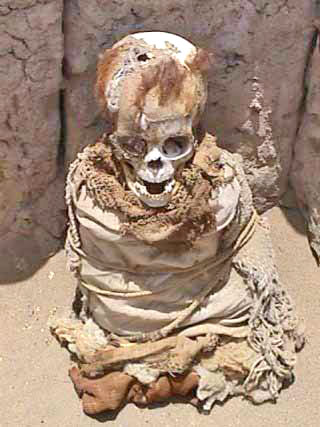 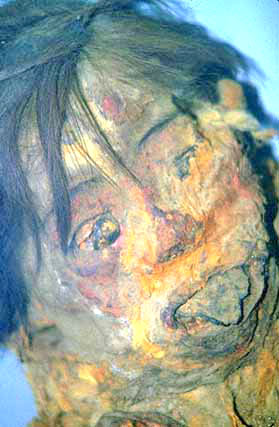
Stunningly preserved
in the dry soil of the Peruvian desert are the mummified bodies of
the Nazcan people themselves.
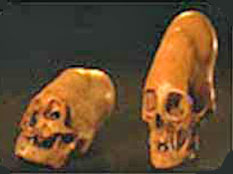
Nazca Skulls with Enlarged cranium
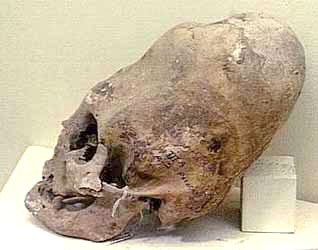
Incan Skulls
 Originally
believed to have been a military stronghold, Cahuachi is now
reckoned to be a place of ritual and ceremony, and Orefici’s
stunning new evidence confirms this idea. Originally
believed to have been a military stronghold, Cahuachi is now
reckoned to be a place of ritual and ceremony, and Orefici’s
stunning new evidence confirms this idea.
Cahuachi is now revealed to have been
abandoned after a series of natural disasters destroyed the city.
But before they left it, the Nazcan
people covered the city in the arid pampa sand where, until
recently, it has remained a barely visible mound in the desert.
Preserving the Nazca Lines
It is difficult to keep the Nazca Lines free from outside
intervention. As with all ancient ruins, such as
Machu Picchu,
weather by wind and rain, and human tampering will take their toll
on these ancient Lines.
In recent years the Nazca Lines have suffered gradual destruction,
as tomb raiders seeking pre-Inca artifacts scar the terrain with
hundreds of burrows, garbage, among other waste material. A boom in
copper and gold mining - including a mine built in 1997 a few feet
from a 2,000-year-old, two-mile-long trapezoid -- is defacing parts
of the Nazca Lines with tracks from truck traffic.
Over the past decade, advertisers and political campaigns have
carved huge messages in the rock and sand between the ancient
designs in this region 250 miles south of Lima.
In 1998, floods and mudslides from the El Nińo weather pattern
seriously eroded several figures.
As electricity reaches the growing local population, utility
companies are running power cables over and around the site.
The damage to the Lines underscores Peru’s desperate struggle to
preserve its national patrimony. Archaeologists say they are
watching helplessly as the quest for scholarship and conservation in
a country viewed as the cradle of New World civilization is losing
out to commercial interests, bleak poverty and the growing
popularity of heritage sites as tourist attractions.
Articles
in the News
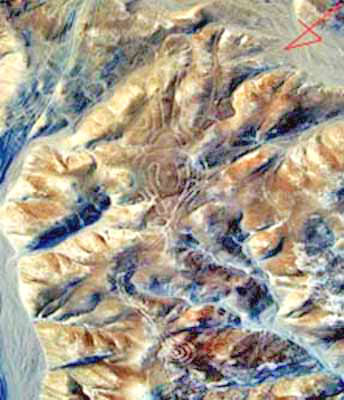
Japanese researchers
find new giant picture on Peru’s Nazca Plateau
MSN - April 21, 2006
A new giant picture on the Nazca Plateau in Peru, which is
famous for giant patterns that can be seen from the air, has
been discovered by a team of Japanese researchers.
The image is 65 meters long, and appears to be an animal with
horns. It is thought to have been drawn as a symbol of hopes for
good crops, but there are no similar patterns elsewhere, and the
type of the animal remains unclear.
The discovery marks the first time since the 1980s that a
picture other than a geometrical pattern has been found on the
Nazca Plateau. The picture was found by a team of researchers
including Masato Sakai, an associate professor at Yamagata
University, after they analyzed images from a U.S. commercial
satellite.
They confirmed it was a previously undiscovered picture in a
local survey in March this year. It is located south of the
Nazca Plateau, and apparently went undiscovered since few
tourist planes pass over the area.
Two parts of the picture, that appear to be horns, bear close
resemblance to those that appear on earthenware dating from 100
B.C. to A.D. 600, during the time when the Nazca kingdom
flourished, and it is thought that they relate to fertility
rites.
The research team will use images from the advanced
land-observing satellite "Daichi," which was launched by the
Japan Aerospace Exploration Agency in January this year, to
create a distribution map of images on the earth that can be
seen from the air. There is evidence that vehicles had driven in
the area, and part of the picture is destroyed.
"We want to
identify all the images, and work to preserve earth pictures
that are gradually being destroyed," Sakai said.
Giant Figures in Peru Desert Pre-date
Nazca Lines
--
The Epoch Times, May 24, 2005
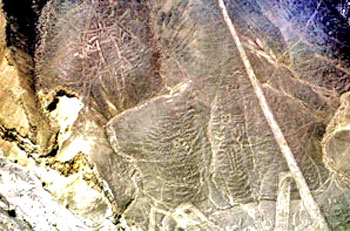
PARACAS
GEOGLYPHS:
Three figures
made by the ancient Paracas culture can be seen outlined
on the rocky
hillsides near Palpa, southern Peru.
The figures are
known as the “Temple of Fertility”,
with a man (top
left), a woman (bottom right) and a divine figure (bottom
center).
A group of about 50 drawings of
giant figures recently discovered in the hills of Peru’s
southern coastal desert near the city of Palpa has been said to
predate the famous Nazca lines nearby. Mr. Johny Isla, director
of the Andean Institute of Archaeological Studies, said the
'geoglyph' figures appear to have been created by the Paracas
communities between 500 and 400BC, whereas the Nazca culture
developed after 50 BC.
Mr. Isla and his partner Dr. Markus Reindel from the
Dutch
Institute of Archaeology discovered the Paracas figures using
aerial photography and land-based surveys. The figures of
humans, birds, monkeys and cats vary in size from 10m to 50m
across, and are also grouped together in areas up to 60 m to 90
m across.
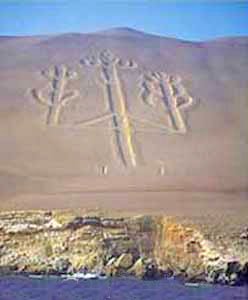
El Candelabro
The Paracas figures were created by removing dark stones in
order to expose the lighter surface underneath. Some areas were
cleared and others built up with rock, creating figures in high
and low relief. With the Nazca lines though, the geoglyphs were
only made by clearing low-relief areas. Until recently
scientists believed that the figures in the Palpa and Nazca
regions were only from the Nazca culture. Mr. Isla says cultural
dating and style of the newly found Paracas figures sets them
apart.
Mr. Isla told The Epoch Times:
"Most of these geoglyphs belong
to the Nazca culture but our recent studies demonstrated
that there are at least 50 geoglyphs pertaining to the
Paracas culture. These new figures are definitely different
and older than those of the Nazca culture.
-
First, the Paracas figures
were drawn on the slopes of the hills, while the Nazca
images were drawn in level areas.
-
Second, the Paracas figures
are smaller and were made in a naturalistic style, while
the Nazca figures are bigger and stylized.
-
Third, the Paracas figures
are mostly arranged in groups, while the Nazca figures
are arranged individually.
-
Finally, it is important to
note that not one of the Paracas figures were repeated
in the Nazca iconography," Mr, Isla said.
|

 Location
Location




























 Originally
believed to have been a military stronghold, Cahuachi is now
reckoned to be a place of ritual and ceremony, and Orefici’s
stunning new evidence confirms this idea.
Originally
believed to have been a military stronghold, Cahuachi is now
reckoned to be a place of ritual and ceremony, and Orefici’s
stunning new evidence confirms this idea. 

